#female figurines
Explore tagged Tumblr posts
Text

The Goddess Remembered
35,000 years of the goddess-worshipping religions - ©2008 Max Dashu of the ancient past
14 notes
·
View notes
Text
i found this awesome artist Libor Balák who paints a lot of prehistoric reconstructions for museums etc. i did already know some of his paitnings but wasn't aware what his name is... he deserves to be recognised for his works... so here are his reconstructions of the Lengyel culture taken from his website (one of my favourite cultures btw)
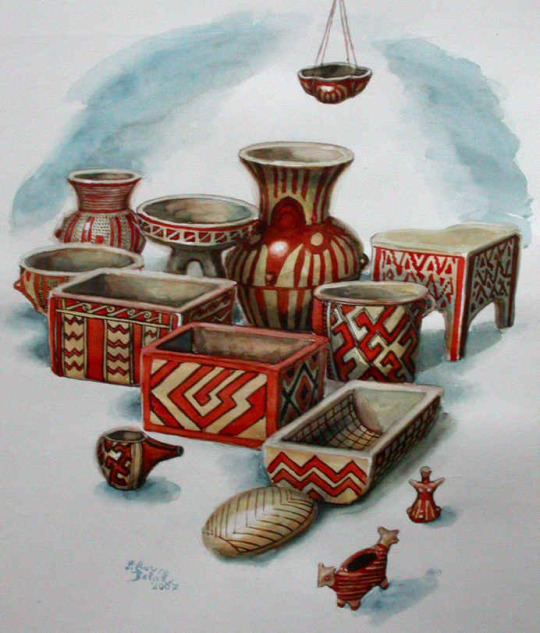
This Neolithic culture has left a distinctive archaeological signature centred in southern Moravia, but also included southwest Slovakia and adjacent parts of Austria and Hungary. Temporally belongs to late Neolithic – about 5000 B.C.
Colourfully decorated ceramics constituted a distinct element of this culture, which subsequently spread into northern Poland, Bohemia and central Germany. Apart from pots, ceramic spoons, ladles, cubic lamplets and models of various objects and structures are known from southern Moravia. This society also possessed advanced agriculture.

Model of a small dwelling is transformed into reality
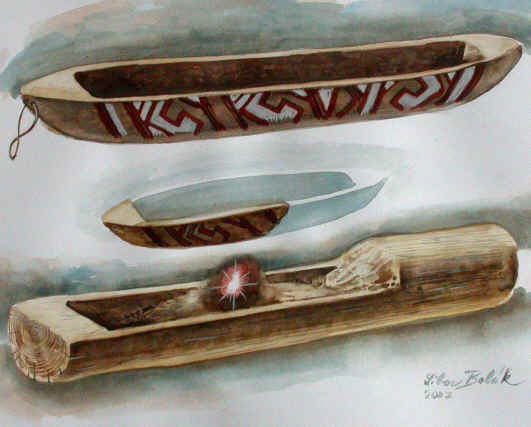
Ceramic fragment labelled as a ship is transformed into watercraft decoration – a monoxylon manufactured from a single piece of tree trunk
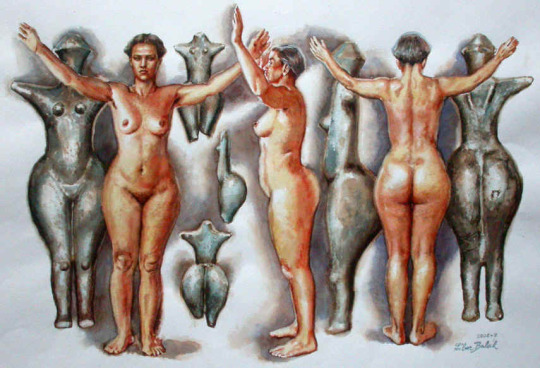
The meaning of the nakedness of the figurines is also controversial; some of the figurines could have had clothes painted on them..
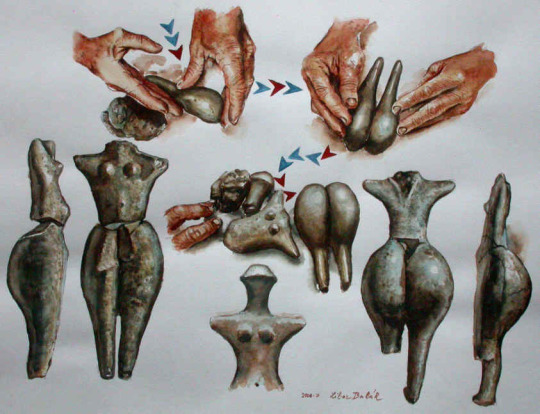
The painting displays the technological stages of Venus figurine manufacture
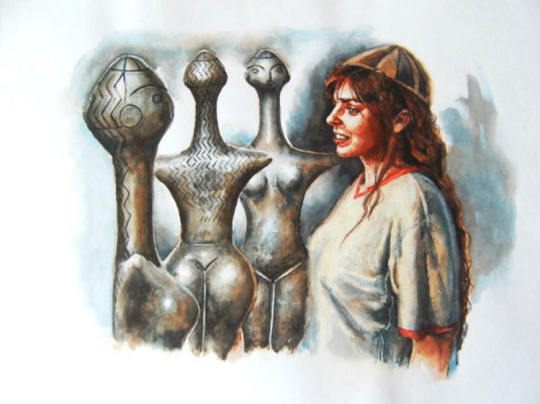
The Middle European Lengyel statuettes are first of all of a high handcrafted quality and very decorative. The shapes and patterns are taken over from the earlier statuettes. Some of them bear specific anatomical and ethnographic elements, such as the Venuse with schematic curly hair.

This statuette has schematic straight hair.
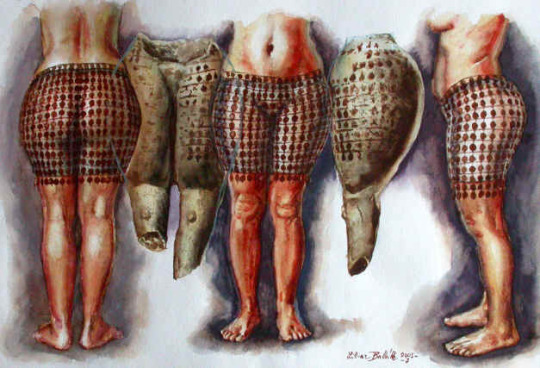
One of the many pieces of the Venus figurines from Neolithic era, found in South Moravia. This fraction has a preserved coloration with geometrical patterns.The figurine is uncomplete, it could also have had complet clothing.

The figurine of a woman in a skirt is decorated with ceramic lugs. The statuette could also be wearing a complete dress, not only a skirt on a bare body
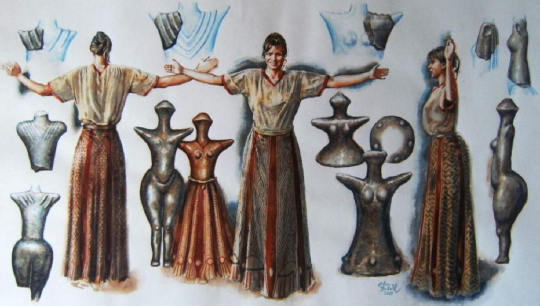
The reconstructive transformation on this picture analyzes the skew elements in the place of the shoulder blades – it could be draped textiles
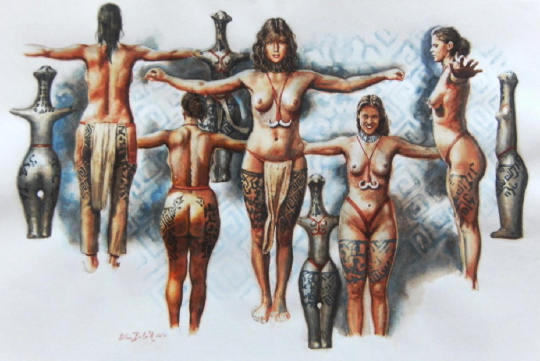
On this statuette found in Austria we can see the preserved traces of the original painting. The interesting fact is also the hole between it´s tights. It could serve for interlacing of the waistcloth or, less probably, for fixing of the figure to the base; the fingertips would hinder the perfect fixing. The image represents the possibilities of the painting interpretation – the decorative leggings on the tights, tattooes, paintings on the skin and a necklace in the form of boar tusks. We can also see the decoration on the neck.
#lengyel culture#neolithic#archaeology#prehistory#stone age#figurines#female figurines#pottery#artefact#reconstruction#anthropomorphic figurine#my upl#Libor Balák#art#czech art
15 notes
·
View notes
Text
Interesting discovery of a cave used as sanctuary from violent times.

11 notes
·
View notes
Text
"A reminder to any woman who looks at her body and finds it flawed: these are prehistoric carvings of goddesses. These represent the epitome of feminine beauty to those we seek to emulate when we go on diets. Not a flat tummy, thigh gap, or gravity-defying breast among them.
These are bodies that are unique to their owners, and contain stories of desire, creation, hardship, and perseverance. These are bodies that are ready to hold you as you cry. These are bodies that worked every day to provide nourishment, resources and guidance to their communities while also caring for the next generation. They supported one another in their labor, holding one another’s babies while they worked crafting tools, collecting water & singing songs to teach the young about the goddesses they so closely resembled.
And these carvings weren’t found in just one area. They’ve been discovered nearly everywhere humanity has settled and thrived. Which means there was a time when womanhood, in all her power and capacity, was revered not as merely a sexual novelty or shunned as sinful temptation, but seen as a source of inspiration to create, to connect, and to find courage.
Today, our patriarchal society reveres conformity in women over all. It demands that women strive to achieve and maintain a form that resembles an untested girl. Our bodies must look perpetually untouched, unspoiled, a blank slate for a man to claim and use and write his own story upon. Instead of worshiping women as they are, we scrutinize and discard them as never good enough. And the more we strive to conform, the more we give up control of our bodies.
So have comfort, women: with each fat roll and jiggle you gain as you move forward in time, you come closer to resembling the goddess as she originally appeared in the hearts of humanity. She lives in you and longs to be seen and revered as she was before.
And you deserve to be worshipped."
~ Alaura Weaver
Photo source: http://albertis-window.com/2012/04/excavation-sites-for-prehistoric-and-ancient-female-figurines/
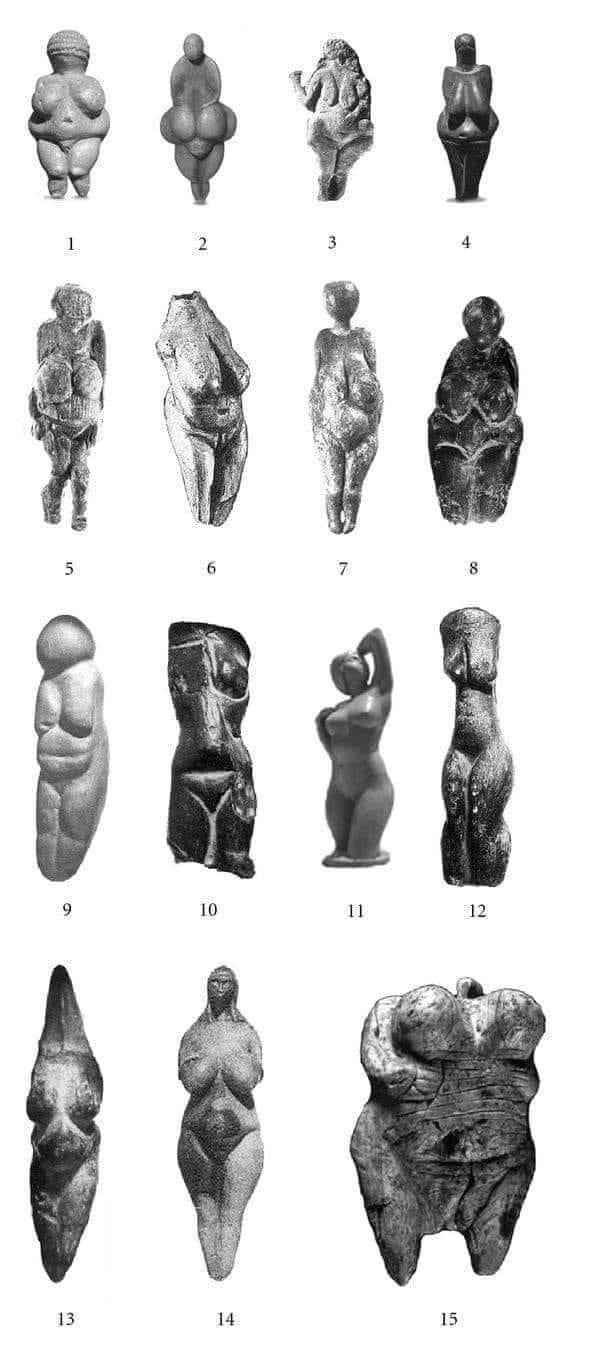
2 notes
·
View notes
Text
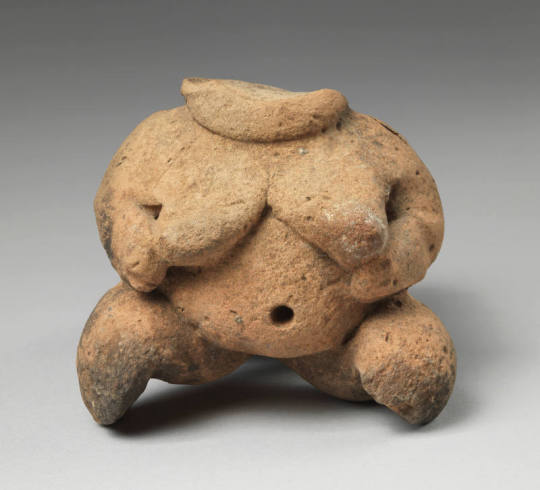
~ Female Fertility Figurine.
Place of origin: Türkiye
Period: Neolithic
Date: 7th Millennium B.C.
Medium: Ceramic
#ancient#ancient art#history#museum#archeology#ancient sculpture#ancient history#archaeology#female fertility figurine#Neolithic#türkiye#turkish#ceramic#7th millennium B.C.
2K notes
·
View notes
Text

The Fireplace, 1994
#vintage#vintage interior#1990s#1700s#fireplace#marble#foliage#motif#damask#wallpaper#sculpture#female#figurine#antique#candlesticks#gold#classical#neoclassical#style#home#architecture
246 notes
·
View notes
Text

#humanformers#jazz#female jazz#maccadam#transformers#transformers jazz#first and last drawing before i go to hell lel#jk maybe ill draw more#depends on theyll let me#har har har im cooked#ill relearn coloring later i think#and ill learn lighting and shadow for the first time later too#dude what if there was a humanformers anime gacha game#you know those anime girl figurines? i forgot the brand. kotobukiya?#i have a plan#and it will stay a plan cuz dude? willingly busting my ass on blender? in 2 years sure
53 notes
·
View notes
Text

8,000-Year-Old Female Figurine Found in Turkey
During the excavations carried out in the Ulucak Mound in the Kemalpaşa district of Izmir, an 8 thousand-year-old female statuette made of clay was found.
With the support of the Ministry of Culture and Tourism, Metropolitan Municipality, Kemalpaşa Municipality and Kemalpaşa Organized Industrial Zone , excavations continue in the 8,850-year-old Ulucak Mound, the oldest settlement in Izmir . Trakya University Faculty of Letters, Department of Protohistory and Near-Asian Archaeology, Prof. Dr. During this year's excavations at the mound, where Özlem Çevik took over the excavation directorate in 2009, an approximately 8 thousand-year-old female figurine was found.
Prof. stated that one of the first village settlements of Izmir was Ulucak Mound. Dr. Özlem Çevik said, "Ulucak represents one of the earliest farming village settlements in Western Anatolia. It is important for us to understand the neolithization process. The first settlement in the mound dates back to 8,850 years ago. Ulucak Höyük has been inhabited uninterruptedly for 1150 years, that is, for 45 five generations." We see that the neolithic settlement continues in this year's mound. One of the most important finds we have found so far is a female figure. Generally, we find parts of figures such as arms, legs and heads in Ulucak. "It is the 6th figure that has ever been found in its entirety," he said.



Emphasizing that the depicted female statuette can be predicted to have a privileged position within the community, Prof. Dr. Çevik said, "It may represent the person who lives here and tells stories in the community. It is made of clay. It is 8-10 centimeters in size. It can fit in a hand. It can be found inside houses, next to ovens, buried in pits under door thresholds, or in association with grinding stones , or in a "We find it associated with flints in the container. They may be ritual objects used to fulfill an intention, action or wish," he said.
Prof. pointed out that the most important element that distinguishes the female figurine found from others is that its mouth is indicated. Dr. Çevik said, "Because the figures usually show eyes and nose. In this figure, we see that the mouth is indicated as a hole, and a hole is made on the neck, which can be used as a jewelry."



#8000-Year-Old Female Figurine Found in Turkey#clay#clay art#clay figurine#ancient artifacts#archeology#ancient culture#history#history news#ancient history#archeolgst#ancient civilizations#ancient art#art history
68 notes
·
View notes
Text

Egyptian
Female Figurine, ca. 1938-1630 B.C.E.
Brooklyn Museum
#ancient art#ancient cultures#figurine#ancient egypt#egypt#egyptian#egyptology#female figure#egyptian art#art history#aesthetictumblr#tumblraesthetic#tumblrpic#tumblrpictures#tumblr art#aesthetic#beauty#tumblrstyle
61 notes
·
View notes
Text
"It's so sad to see Dandadan get full of nazis" Any popular anime will eventually get a significant base of nazis and bigots because anime as a genre is filled with this kind of fans. And why wouldn't it be a hot spot for alt-right guys? Animes constantly treat women like sexual objects, poc are rarely represented and when they do it's often a racist caricature, pedophilia is rampant, characters are always European-coded with blue eyes and/or blonde hair and a lot of anime plots tap into men's insecurities and desires (see "loser and lonely guy suddenly becomes super powerful and has at least one pretty girl fall in love with him"). The average anime is build in a lab to appeal to this kind of people and it's progressive fans who are the exception. The only major genres I can think of that don't have this problem are yaoi and yuri, because gay couples and woman-centered stories are radioactive to nazis. Which means that in order to push nazis away from your anime you have to put some queers in it. In this essay I will-
#m#animanga#dandadan#i was going to also add animes with an all female cast but then i remembered k-on and the dragon maid one exist#so idk what makes it so sailor moon fans are normal while k-on fans are on a fbi list#anyway this is a problem and it will likely remain as such for a long time bcs japan is more conservative that the west#and also deranged fans are the ones buying expensive figurines and blurays so-#btw the last bit of the post is half joke half serious#i mean yuri on ice or utena to name some dont have this problem thats all im saying
23 notes
·
View notes
Text

The Venus of Dolní Věstonice is a Venus figurine of female figure dated to 29,000–25,000 BC. It was found at the Paleolithic site Dolní Věstonice in the Moravian basin south of Brno, in the base of Děvín Mountain in which is present-day Czech Republic.
Source: Ancient Library
#Ancient Library#ancientlibrary.com#The Venus of Dolní Věstonice#Venus figurine#female figure#ancestors alive!#what is remembered lives#memory & spirit of place#ancient ways#sacred ways#life#29000-25000 BC#Paleolithic site Dolni Věstonice#Dolní Věstonice#Moravian basin#Moravia#Brno#Děvín Mountain#Czech Republic#Goddess
35 notes
·
View notes
Photo

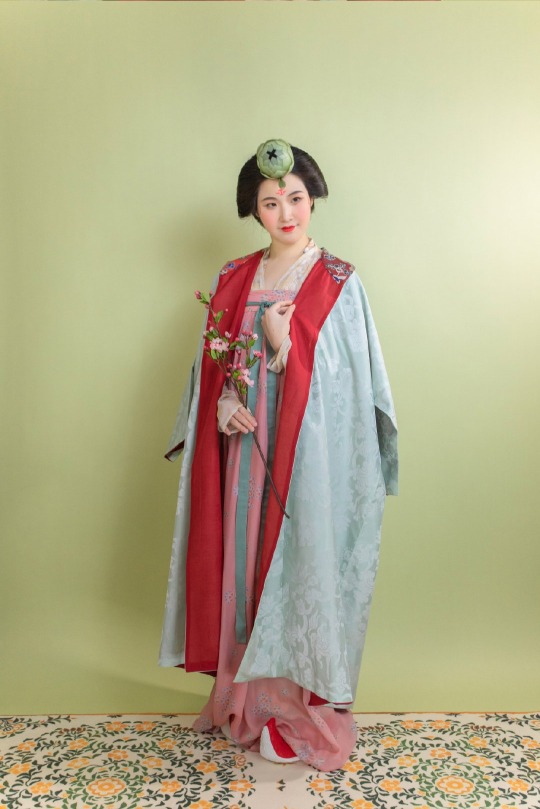








【Historical Artifacts Reference】
Chinese Tang Dynasty Female Figurines in “乌蛮髻/Wū mán Hairstyle”
some will put lotus flowers in the middle of the hair
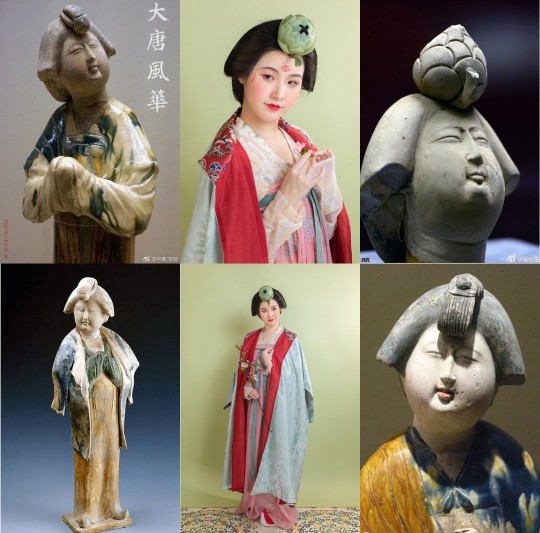

[Hanfu · 漢服]Chinese Tang Dynasty(618-907A.D) Traditional Clothing Hanfu & Hairstyle Based On Tang Dynasty Female Figurines
High Tang Period Women Attire and Hairstyle
————————
📸Recreation Work: @吃货娃娃
🔗Weibo:https://weibo.com/1868003212/MD7GFiYs0
————————
【Shangsi Festival/Double Third Festival/上巳節】
Double Third Festival or Shangsi Festival (traditional Chinese: 上巳節) is a Chinese festival celebrated on the third day of the third month of the Chinese calendar.
It is said that the origin of this festival comes from the Dinner Party at the Qushui River during the Zhou Dynasty (about 1100–221 BC). Others say its origins come from the ceremonial custom of getting rid of evils by bathing in the river. On this day, people would hold a sacrificing ceremony on a riverside to honor their ancestors, and then take a bath in the river with herbs to cleanse their bodies of filth. Following that, young men and women would then go for a spring outing in which many of these scenes were described in Shi Jing (The Book of Songs).
The Shangsi Festival activities have changed over the course of subsequent dynasties. The entertainment feast and praying for descendants along the riverside were added in the Han Dynasty (206 BC-220 AD). It was after the Wei and Jin dynasties (220–420 AD) that the festival developed into the Double-Third (Shangsi) Festival that is fixed on the third day of the third lunar month.
In modern times, to observe this festival, people would go for an outing by the water, have picnics, and pluck orchids. It is also a day for invoking cleansing rituals to prevent disease and get rid of bad luck. The day is also traditionally considered to be a possible birthday of the Yellow Emperor.
The ancient traditions of Shangsi are mostly celebrated by several communities spread out among the provinces today, such as the ancient village of Xinye
The great calligrapher Wang Xizhi mentions this festival in his famous work Preface to the Orchid Pavilion Poems, written in regard to the Orchid Pavilion Gathering during the Six Dynasties era.
The Han ethnic people in some places also have special customs on March 3rd. For example, Hunan and other places have the tradition of "March 3rd, boiled eggs with ground (shepherd's) purse", while Anhui and other places have the tradition of eating Baba( a kind of bread, with meat):

#Chinese Hanfu#Tang Dynasty(618-907A.D)#High Tang Period (650-755 AD)#hanfu#hanfu history#Shangsi Festival#Double Third Festival#上巳節#chinese food#hanfu accessories#hanfu artifacts#Tang Dynasty Female Dancer Figurine#chinese traditional clothing#chinese history#historical clothing#historical hairstyles#chinese coustume#China History#吃货娃娃#齊胸衫裙 qixiong shanqun#pibo 披帛#乌蛮髻(Wū mán Hairstyle)
253 notes
·
View notes
Text

#goddess figurine#goddess worship#red goddess#babalon#neolithic style goddess#fertility goddess#root chakra#divine feminine#infernal divine#primal goddess#dark feminine#underworld goddess#godess#sacred woman#divine femaleness
14 notes
·
View notes
Text

necronyu on twt
#anime#figures#manga#anime and manga#saya no uta#blame!#collection#figurine#plushies#femcel#incel#incelcore#female incel#room decor#bedroom#bed rotting#shelf
11 notes
·
View notes
Text


°·.¸.·°¯°·.¸.·°¯°·.¸.-> 🎀 𝐸𝑒𝓋𝑒𝑒 𝒞𝓁𝒶𝓎 𝒜𝓇𝓉❣❢ 🎀 >-.¸.·°¯°·.¸.·°¯°·.¸.·°
#ninjastarart#pokemon#custommade#crafts#clay art#polymer clay#Eevee#i love eevee#i made this#female Eevee#painted clay#clay model#clay figurine#pokémon art#pokémon fanart#gotta catch em all#my favorite pokemon
15 notes
·
View notes
Text


"Red-headed goddess" - statuette from the early Neolithic period (archaeological site Donja Branjevina, Odžaci, Vojvodina, Serbia)
#artefact#venus figurine#neolithic#prehistory#archaeology#starcevo culture#starcevo complex#stone age#serbia#female figurine#art#prehistoric art#my upl#Steatopygia
7 notes
·
View notes